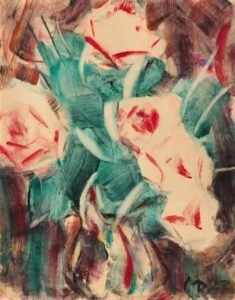[\[]\Exploring the Bold World of Christian Rohlfs: Expressionism’s Underrated Master
Exploring the Bold World of Christian Rohlfs: Expressionism's Underrated Master
Who Was Christian Rohlfs?
Let’s start with the basics. If you haven’t heard of Christian Rohlfs, you’re not alone. He’s often overshadowed by bigger names in the Expressionist movement, but that doesn’t mean his work is any less impactful. In fact, once you dive into his art, you’ll see why many art historians consider him one of Expressionism’s true pioneers.
Born in 1849 in Niendorf, Germany, Rohlfs didn’t take a traditional path to artistic fame. His early life was plagued with illness, and he originally studied to become a teacher. However, a deep love for art eventually pulled him toward painting, and by the age of 21, he was studying at the Weimar Art School.
Interestingly, Rohlfs started his career as a realist and academic painter. His early works reflected the traditions of the 19th century, but like many artists of his time, he evolved. And evolve he did—dramatically.
From Realism to Expressionism: An Artistic Transformation
Transitioning from realism to expressionism wasn’t an overnight process for Rohlfs. Over the years, his style shifted dramatically, influenced by other groundbreaking artists and cultural movements.
One major turning point came in 1901, when he met Edvard Munch and Emil Nolde. Their influence helped spark a creative awakening in Rohlfs, inspiring him to explore color, emotion, and abstraction more freely.
Another critical moment? His exposure to Vincent van Gogh. Rohlfs was captivated by Van Gogh’s use of color and form, and you can definitely see echoes of that inspiration in his later work.
By the early 1900s, Rohlfs was creating bold, emotional paintings that embraced the raw power of the Expressionist movement. He focused on landscapes, figures, and florals—each painted with thick brushstrokes, exaggerated colors, and a deep sense of feeling.
Fun fact: Rohlfs didn’t actually join the Die Brücke or Der Blaue Reiter groups, but his work is often discussed alongside theirs because of its powerful emotional content and visual intensity.
Signature Works and Themes

So what does a Christian Rohlfs painting look like? Imagine wild, swirling brushstrokes. Colors that seem to jump off the canvas. Figures and landscapes distorted just enough to feel intense, but still familiar.
One of his standout works is “Rote Blumen in Vase” (1919). This piece showcases Rohlfs’ masterful use of color and form, turning a simple vase of flowers into a dramatic, expressive statement. The florals are rendered in bold reds, and the brushwork gives the impression that they might just leap out of the frame.
Another notable piece is his series of crucifixion scenes, painted in his later years. These works are deeply emotional and spiritual, often described as some of the most moving religious-themed paintings of the Expressionist era.
Throughout his body of work, Rohlfs returned to a few key themes:
Nature and landscapes
Floral still lifes
Human emotion and suffering
Spirituality and symbolism
Each painting carries a raw intensity that feels both personal and universal. That’s the magic of Rohlfs. His art speaks a language of emotion that crosses time and culture.
The Legacy of Christian Rohlfs

Despite his contributions to modern art, Christian Rohlfs doesn’t always get the recognition he deserves. Part of that is due to his complex relationship with the German political climate of his time.
In the 1930s, when the Nazis rose to power, Rohlfs’ art was labeled “degenerate.” In 1937, his works were removed from German museums, and he was expelled from the Prussian Academy of Arts. Tragically, he died just a year later in 1938.
But history, thankfully, has a way of correcting itself. In the decades since his death, Rohlfs has received renewed attention. Museums and collectors have rediscovered his genius, and his works are now housed in major institutions, including the Christian Rohlfs Museum in Hagen, Germany.
Today, Rohlfs is celebrated for his fearless experimentation and emotional honesty. He is often credited with helping to pave the way for abstract and modern art in the 20th century. And as interest in Expressionism continues to grow, so too does appreciation for his bold, passionate work.
Final Thoughts: Why Christian Rohlfs Still Matters
So why should you care about Christian Rohlfs today? Because his story is a reminder of what art is truly about: expression, emotion, and the courage to evolve. Rohlfs didn’t follow trends—he followed his heart. He transformed personal struggle into visual poetry, and that’s something we can all learn from.
Whether you’re a seasoned collector, a student of art history, or someone who simply loves bold color and emotional depth, Christian Rohlfs offers something powerful. His art speaks in brushstrokes, in hues, in texture—telling stories that are just as relevant now as they were a century ago.
Take a moment to explore his work. You just might find a new favorite artist in this underrated master of Expressionism.
Who Was Christian Rohlfs?
Let’s start with the basics. If you haven’t heard of Christian Rohlfs, you’re not alone. He’s often overshadowed by bigger names in the Expressionist movement, but that doesn’t mean his work is any less impactful. In fact, once you dive into his art, you’ll see why many art historians consider him one of Expressionism’s true pioneers.
Born in 1849 in Niendorf, Germany, Rohlfs didn’t take a traditional path to artistic fame. His early life was plagued with illness, and he originally studied to become a teacher. However, a deep love for art eventually pulled him toward painting, and by the age of 21, he was studying at the Weimar Art School.
Interestingly, Rohlfs started his career as a realist and academic painter. His early works reflected the traditions of the 19th century, but like many artists of his time, he evolved. And evolve he did—dramatically.
From Realism to Expressionism: An Artistic Transformation
Transitioning from realism to expressionism wasn’t an overnight process for Rohlfs. Over the years, his style shifted dramatically, influenced by other groundbreaking artists and cultural movements.
One major turning point came in 1901, when he met Edvard Munch and Emil Nolde. Their influence helped spark a creative awakening in Rohlfs, inspiring him to explore color, emotion, and abstraction more freely.
Another critical moment? His exposure to Vincent van Gogh. Rohlfs was captivated by Van Gogh’s use of color and form, and you can definitely see echoes of that inspiration in his later work.
By the early 1900s, Rohlfs was creating bold, emotional paintings that embraced the raw power of the Expressionist movement. He focused on landscapes, figures, and florals—each painted with thick brushstrokes, exaggerated colors, and a deep sense of feeling.
Fun fact: Rohlfs didn’t actually join the Die Brücke or Der Blaue Reiter groups, but his work is often discussed alongside theirs because of its powerful emotional content and visual intensity.
Signature Works and Themes

So what does a Christian Rohlfs painting look like? Imagine wild, swirling brushstrokes. Colors that seem to jump off the canvas. Figures and landscapes distorted just enough to feel intense, but still familiar.
One of his standout works is “Rote Blumen in Vase” (1919). This piece showcases Rohlfs’ masterful use of color and form, turning a simple vase of flowers into a dramatic, expressive statement. The florals are rendered in bold reds, and the brushwork gives the impression that they might just leap out of the frame.
Another notable piece is his series of crucifixion scenes, painted in his later years. These works are deeply emotional and spiritual, often described as some of the most moving religious-themed paintings of the Expressionist era.
Throughout his body of work, Rohlfs returned to a few key themes:
Nature and landscapes
Floral still lifes
Human emotion and suffering
Spirituality and symbolism
Each painting carries a raw intensity that feels both personal and universal. That’s the magic of Rohlfs. His art speaks a language of emotion that crosses time and culture.
The Legacy of Christian Rohlfs
 Despite his contributions to modern art, Christian Rohlfs doesn’t always get the recognition he deserves. Part of that is due to his complex relationship with the German political climate of his time.
Despite his contributions to modern art, Christian Rohlfs doesn’t always get the recognition he deserves. Part of that is due to his complex relationship with the German political climate of his time.
In the 1930s, when the Nazis rose to power, Rohlfs’ art was labeled “degenerate.” In 1937, his works were removed from German museums, and he was expelled from the Prussian Academy of Arts. Tragically, he died just a year later in 1938.
But history, thankfully, has a way of correcting itself. In the decades since his death, Rohlfs has received renewed attention. Museums and collectors have rediscovered his genius, and his works are now housed in major institutions, including the Christian Rohlfs Museum in Hagen, Germany.
Today, Rohlfs is celebrated for his fearless experimentation and emotional honesty. He is often credited with helping to pave the way for abstract and modern art in the 20th century. And as interest in Expressionism continues to grow, so too does appreciation for his bold, passionate work.
Final Thoughts: Why Christian Rohlfs Still Matters
So why should you care about Christian Rohlfs today? Because his story is a reminder of what art is truly about: expression, emotion, and the courage to evolve. Rohlfs didn’t follow trends—he followed his heart. He transformed personal struggle into visual poetry, and that’s something we can all learn from.
Whether you’re a seasoned collector, a student of art history, or someone who simply loves bold color and emotional depth, Christian Rohlfs offers something powerful. His art speaks in brushstrokes, in hues, in texture—telling stories that are just as relevant now as they were a century ago.
Take a moment to explore his work. You just might find a new favorite artist in this underrated master of Expressionism.


